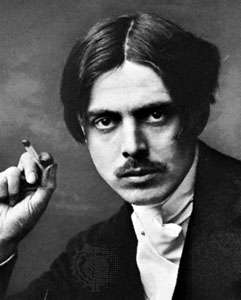Percy Wyndham Lewis Great English Legend of 20th Century
Introduction
Percy Wyndham Lewis (1882-1957) is widely acknowledged as one of the greatest English legendary, artistic and literary polymath of the twentieth century. Not only he made wonderful contributions to the visual arts but he also rendered great services for the society with his influential work as a painter. Moreover, he worked as a draughtsman and a graphic artist. Lewis is also renowned for writing a lot of fictional literature, poetry and literary censure. While his novels were considered harshly satirist by a lot of people, he also appraised the contemporaries of his time in an intensely unfeeling manner (Edwards 2000). He was one of the few main figures who encouraged vorticism, an English futuristic art movement before the beginning of the World War I (Glover 2008). Vorticism was devoted “to simplify forms into machinelike angularity” (“vorticism” 2013). Lewis is also famous for his significant impact on the visual arts development during the twentieth century (Glover 2008).
Percy Wyndham Lewis cofounded a magazine related to vorticism in 1914-1915 and named it Blast. It is important to mention here that his paintings were not limited to the vorticists’ cubism. Lewis contributed significantly by producing several conventional works due to which he gained vital acknowledgment and appreciation. His paintings can be found in a number of museums that also include the world-famous Tate Gallery in London and the Museum of Modern Art in NYC. Being an author, Lewis enjoys a significant position due to his semi-philosophical and iconoclastic literary works including Self Condemned, Time and Western Man, The Apes of God, The Revenge for Love, The Writer and the Absolute, The Art of Being Ruled, Bombardiering, The Childermass and Rude Assignment (“Lewis, Wyndham” 2013).
Lewis’ Influence as a Neoclassical Artist
Lewis was a true neoclassical artist as the standard of his artwork was very high and he always tried to give a sensationally new feel to his art work. The amazing thing about his work was he always displayed the absolute control of expressions. He can be considered genuinely influential to both culture and society as he never made monotonous duplicates of his previously-made creations. Instead, he was able in producing original and inventive pieces consistently and this guaranteed a high standard production always. But, he took more risks as compared to other artists as he whipped out ordinary and inoffensive stuff due to his zealous nature that yearned for uniqueness and unmatched individuality (Edwards 2000).
Thus, instead of simply creating something absolutely unique, Lewis was able to put across culture in a natural manner with all its fundamental elements. As a neo classical artist, Lewis was influential enough to display finesse in his works and regained the missing elements that might have lost into his unconsciousness. Due to this impressive characteristic, Lewis acquired inimitable popularity and success (Edwards 2000).
Lewis Painting Style
Percy Wyndham Lewis also applied opulent and smart styles that led him to create some of the most enchanting paintings including Ezra Pound, Mexican Shawl, Miss Close, Newfoundland, Pensive Head, The Crowd, Workshop, Creation Myth etc. He made use of delicate colors and oil on canvas works for the depiction of strong emotions. Most of his paintings reflect perfect, predetermined and serious tones. However, some of them are also a reflection of lifeless sensuality and private expressions. It can be said that Lewis introduced an interesting trend in the form of neoclassicism and treated classic themes in an entirely different way that was not known to his contemporaries and those before him (Edwards 2000).
A technique, ‘Burying Euclid deep in the living flesh’, was also devised by Lewis. Several of his portraits embed geometrical shapes and this particular feature makes them rather appealing and attention-grabbing and frequently far better than the portraits made by the Royal Academicians of that era (Davies 2008). Lewis was a staunch believer in the uniqueness and individuality of a human being. This is the major reason why almost all of his portraits reflect a devotion to coin an image that will set for this exceptional and distinctive being. He has successfully made everyone of his characters into a different pictorial creature and has given it a perfectly classic shape (Edwards 2000).
Thus, it is not a surprise that more or less each of his triumphant images is of his most powerfully individuating sitters. It won’t be incorrect to state that Lewis has made immortals in the form of his portraits. The man or woman who sat for him to be portrayed was given a shape by him that was their own in real life. His trick was the deployment of geometry at both levels; macroscopic and microscopic. He was not only a master of structuring the whole figure of his sitters but also mastered the characterization of details (Edwards 2000). The best examples of this skill are evident in the heads of Pound and Spender. He has molded each part in a distinct manner. The shaping sense of Lewis “picks out the arch of an eyebrow, the curl of a lip, the twist of a lock of hair, and establishes its identity” (“Was Percy Wyndham Lewis the greatest portraitist of his time? – Features – Art – The Independent” 2008).
If his portraits are closely observed, they portray every bit of an individual. He spots everything from head to toe. The best thing about him is that he gave individual treatment to everything he sees. This makes him a perfect observer and portraitist. Those who follow Lewis as their mentor have a lot to learn as he offers great shaping techniques.
Lewis Writing Style
As far as his writings are concerned, the fiction written by Lewis was often full of harsh, satirical descriptions of his clientele whose thoughtfulness and sympathy were greatly disliked by him. This is an interesting thing that his portraits rarely reflected this resentment. However, his explosive swings between closeness and antagonism for a person totally describes this. It is evident in the fact that he openly criticized famous people like Nancy Cunard, Virginia Woolf etc in his literary works but did not portrayed them unsympathetically in his portraits of them. Lewis influence on the society and culture was immense. It is because people purchase portraits and do not give money to someone who assassinates their characters in a pictographic form. However, Lewis’ case was different. He was so talented that people paid him commissions despite of his thorny and insulting conduct (Davies 2008).
Though Lewis cannot be considered the greatest portraitist the world has witnessed, he was undoubtedly one of those who had been given talent by nature. His work is really interesting as it has “given us a wonderful set of visual images of those prominent in the literary world of the inter-war period; indeed this is how their appearances came to be recognized and remembered” (Davies 2008).
Lewis Vision
Lewis was among those cultural intellectual figures that straightforwardly refused to accept the concepts of bourgeois liberalism and democracy. Throughout the course of his life, Lewis suffered from poverty. Thus, his aim was to do something for the betterment of the artists and gain respect for them in the society. He wished for a society where artists could be honored for their hard work. He believed that humanity was in fact ruled by the artists and therefore he resented everyone that considered art as an article of trade that was sold. His artistic nature molded his outlook towards politics and society. He strongly opposed the dominance of politics and money matters over the culture of a society. This is the reason why he strongly supported Fascism (Bolton 2003).
Conclusion
To cut a long story short, Wyndham Lewis is perhaps the most important twentieth century British artist-writer who introduced the ground-breaking forward-looking and revolutionary modernism in Britain before the First World War This revolution helped London to turn into a global The sad thing is that till now, a lot of general readers and art lovers are not familiar with his name and a lot of specialists have not understood him fully (Humphreys 2004). Nevertheless, of what we do know is that Wyndham Lewis is a true painter and the leader of the Vorticist movement (Edwards 2000).
In short, Wyndham Lewis was the one who introduced this concept and which is greatly acknowledged for being the only significant painting-related English school (Wagner 1957). The outspoken nature of Lewis and his satire stands him apart from the other belonging to the similar fields. Being a prolific writer about society and culture and politics, he introduced ideas that were controversial but admired by many (Edwards 2000).
References
Bolton, K. R. Thinkers of the Right: Challenging Materialism . Luton: Luton Publications, 2003.
Edwards, P. Wyndham Lewis: Painter and Writer . London: Yale University Press, 2000.
Glover, M. “Brilliant Cruelty; Wyndham Lewis’s Portraits Are Wonderfully Ruthless Appraisals of the Literati of His Time.” New Statesman (1996), July 21, 2008. http://www.questia.com/read/1G1-182045253/brilliant-cruelty-wyndham-lewis-s-portraits-are-wonderfully (accessed September 8, 2013).
Humphreys, R. Wyndham Lewis. London: Tate, 2004.
“Lewis, Wyndham from The Columbia Encyclopedia, 6th ed..” Questia. http://www.questia.com/read/1E1-LewisWy/lewis-wyndham (accessed September 8, 2013).
“Was Wyndham Lewis the greatest portraitist of his time? – Features – Art – The Independent.” The Independent | News | UK and Worldwide News | Newspaper. http://www.independent.co.uk/arts-entertainment/art/features/was-wyndham-lewis-the-greatest-portraitist-of-his-time-861134.html (accessed September 8, 2013).
“vorticism from The Columbia Encyclopedia, 6th ed..” Questia. 2013. http://www.questia.com/read/1E1-vorticis/vorticism (accessed September 8, 2013).
Wagner, G. Wyndham Lewis: A Portrait of the Artist as the Enemy. London: Routledge, 1957.

